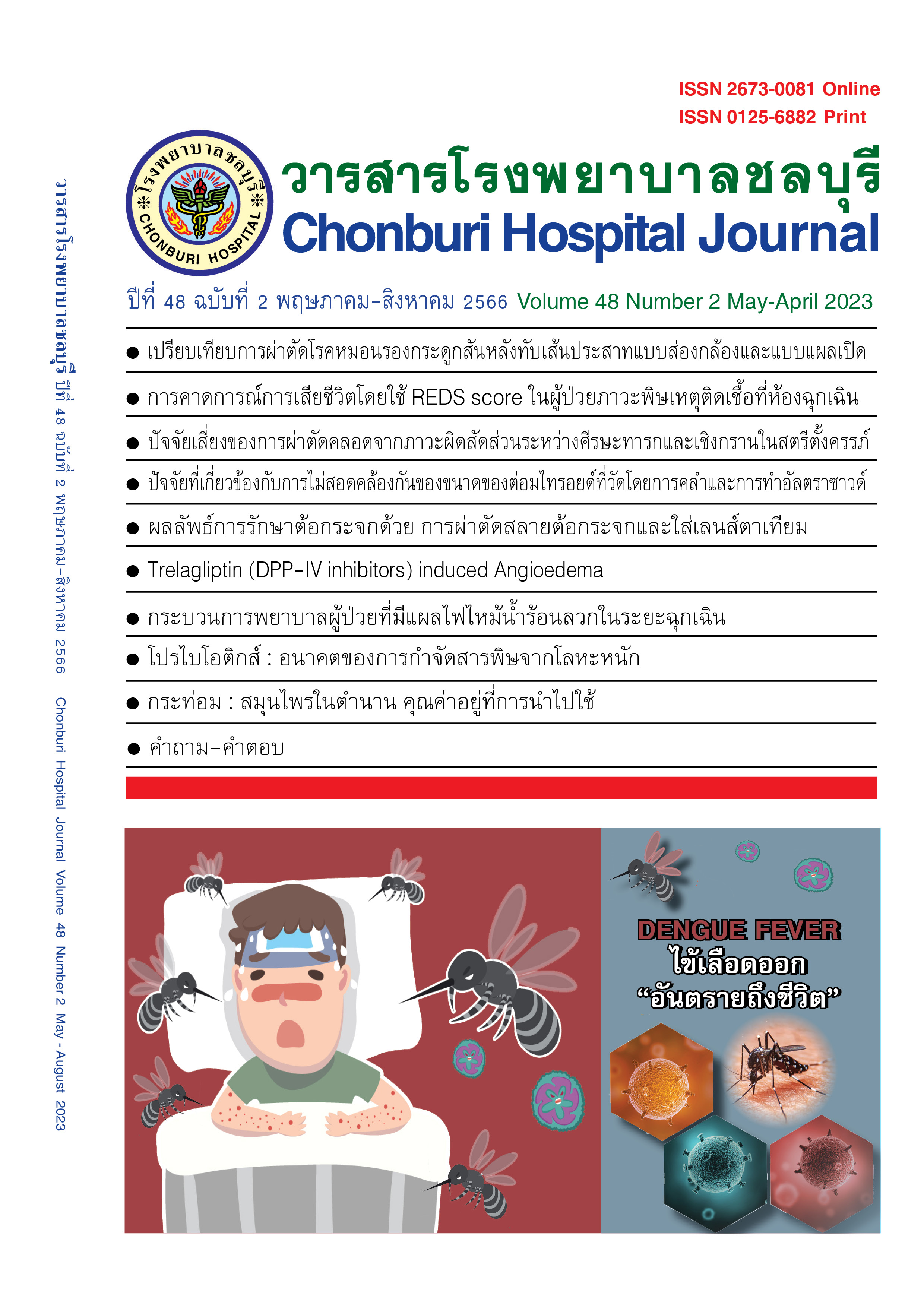Trelagliptin (DPP-IV inhibitors) induced Angioedema: รายงานกรณีศึกษาและการทบทวนวรรณกรรม
บทคัดย่อ
อาการบวมใต้ชั้นผิวหนัง (angioedema) เป็นอาการไม่พึงประสงค์ที่พบได้จากการใช้ยากลุ่ม dipeptidyl peptidase-IV inhibitors (DPP-IV inhibitors) ได้แก่ sitagliptin, alogliptin, vildagliptin และ trelagliptin เป็นต้น ซึ่งในปัจจุบันมีการใช้กันอย่างแพร่หลายในการรักษาโรคเบาหวานชนิดที่ 2 โดยอาการไม่พึงประสงค์นี้พบได้ไม่บ่อย แต่รุนแรงและเป็นอันตรายถึงชีวิตได้ จึงจำเป็นต้องได้รับการรักษา และหยุดยาที่เป็นสาเหตุโดยเร็ว ระยะเวลาตั้งแต่ได้รับยาจนเกิดอาการไม่แน่นอน ไม่สามารถคาดการณ์ได้ ดังนั้น บุคลากรทางการแพทย์ควรเฝ้าระวังและให้ข้อมูลแก่ผู้ป่วยเพื่อสังเกตอาการของตนเองในเบื้องต้น
โดยในบทความนี้เป็นรายงานผู้ป่วยชายไทย อายุ 60 ปี ได้รับการวินิจฉัยว่าเป็น cutaneous plasmacytoma ปัจจุบันได้รับสูตรการรักษาสูตร VRd และโรคเบาหวานชนิดที่ 2 ปัจจุบันได้รับการรักษาเป็น glimepiride และ trelagliptin ครั้งนี้ผู้ป่วยเข้ารับการรักษาเรื่องตาบวม ร่วมกับผื่นคันตามร่างกาย และมีความผิดปกติของระบบเลือด แพทย์เฉพาะทางผิวหนังและแพทย์เฉพาะทางภูมิคุ้มกัน ร่วมกันวินิจฉัยว่าเป็น trelagliptin induced angioedema และ lenalidomide, fluconazole และ co-trimoxazole induced early Drug Rash with Eosinophilia and Systemic Symptoms (DRESS) จึงพิจารณาหยุดยาที่สงสัยทั้งหมด และให้การรักษาด้วย prednisolone, bilastine และ triamcinolone cream จนอาการหายเป็นปกติ
เอกสารอ้างอิง
Brown NJ, Byiers S, Carr D, Maldonado M, Warner BA. Dipeptidyl peptidase-IV inhibitor use associated with increased risk of ACE inhibitor-associated angioedema. Hypertension. 2009;54(3):516-23.
Beaudouin E, Defendi F, Picaud J, Drouet C, Ponard D, Moneret-Vautrin DA. Latrogenic angioedema associated with ACEi, sitagliptin, and deficiency of 3 enzymes catabolizing bradykinin. Eur Ann Allergy Clin Immunol. 2014;46(3):119-22.
Gülbahar O. Angioedema without wheals: a clinical update. Balkan Med J. 2021;38(2):73-81.
Noguchi Y, Murayama A, Esaki H, Sugioka M, Koyama A, Tachi T, et al. Angioedema caused by drugs that prevent the degradation of vasoactive peptides: a pharmacovigilance database study. J Clin Med. 2021;10-9.
Cassano N, Nettis E, Di Leo E, Ambrogio F, Vena GA, Foti C. Angioedema associated with dipeptidyl peptidase-IV inhibitors. Clin Mol Allergy. 2021;19(1):24-36.
Byrd JS, Minor DS, Elsayed R, Marshall GD. DPP-4 inhibitors and angioedema: a cause for concern? Ann Allergy Asthma Immunol. 2011;106(5):436-8.
Kaku K. First novel once-weekly DPP-4 inhibitor, trelagliptin, for the treatment of type 2 diabetes mellitus. Expert Opin Pharmacother. 2015;16(16):2539-47.
Grimshaw CE, Jennings A, Kamran R, Ueno H, Nishigaki N, Kosaka T, et al. Trelagliptin (SYR-472, Zafatek), novel once-weekly treatment for type 2 diabetes, inhibits dipeptidyl peptidase-4 (DPP-4) via a non-covalent mechanism. PLoS One. 2016;11(6):1-14.
Kalambay J, Ghazanfar H, Martes Pena KA, Munshi RA, Zhang G, Patel JY. Pathogenesis of drug induced non-allergic angioedema: a review of unusual etiologies. Cureus. 2017;9(8):1-8.
Schnyder B, Brockow K. Pathogenesis of drug allergy--current concepts and recent insights. Clin Exp Allergy. 2015;45(9):1376-83.
Hermanrud T, Bygum A, Rasmussen ER. Recurrent angioedema associated with pharmacological inhibition of dipeptidyl peptidase IV. BMJ Case Rep. 2017;1-4.
Rubinstein E, Stolz LE, Sheffer AL, Stevens C, Bousvaros A. Abdominal attacks and treatment in hereditary angioedema with C1-inhibitor deficiency. BMC Gastroenterolo. 2014;14(1):71-80.
Ejikeme C, Nwachukwu C, Viechweg JL, Ejikeme I, Brescia M. DPP-IV inhibitor–associated angioedema in patient with known history of ACE inhibitor angioedema. J Investig Med. 2021;9:1-3.
Woodard-Grice AV, Lucisano AC, Byrd JB, Stone ER, Simmons WH, Brown NJ. Sex-dependent and race-dependent association of XPNPEP2 C-2399A polymorphism with angiotensin-converting enzyme inhibitor-associated angioedema. Pharmacogenet Genomics. 2010;20(9):532-6.
Riedl MA, Casillas AM. Adverse drug reactions: types and treatment options. Am Fam Physician. 2003;68(9):1781-90.
Ballester-Martínez MA, González-García C, Fleta-Asín B, Burdaspal-Moratilla A, Santón-Roldán A, Jiménez-Gómez N, et al. Cutaneous nodules as a diagnostic clue in multiple myeloma. Am J Dermatopathol. 2013;35(3):377-80.
Yoo J, Jo M, Kim MS, Jue MS, Park HJ, Choi KH. Cutaneous plasmacytoma: metastasis of multiple myeloma at the fracture site. Ann Dermatol. 2017;29(4):483-6.
ดาวน์โหลด
เผยแพร่แล้ว
ฉบับ
บท
การอนุญาต

This work is licensed under a Creative Commons Attribution-NonCommercial-NoDerivatives 4.0 International License.
บทความที่ได้รับการตีพิมพิ์เป็นลิขสิทธิ์ของวารสารโรงพยาบาลชลบุรี
